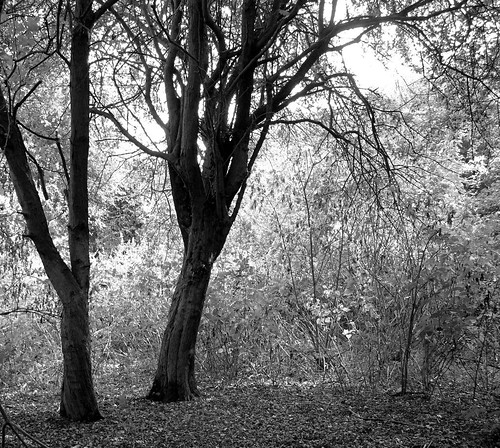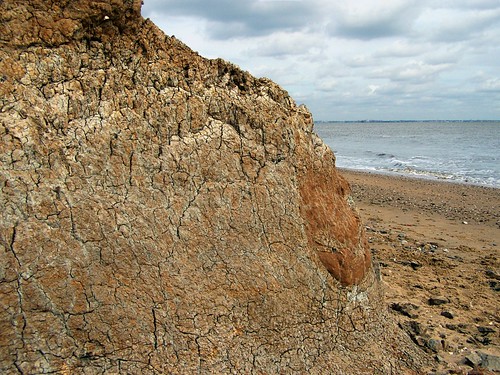Breaking through the brush line the world of the open plain is obliterated, this is a far more enclosed space where you can walk through tunnels of green before emerging into areas more open.
Before the war this was a links golf-course, the government bought it with the onset of war and that did for the golf course. The clubhouse was by the tower. Traces of the course can be imagined in the landscape that remains, a few old photographs give hints. An OS Map from the 1950’s shows buildings huddled around the tower, the modern shop/eatery/catch penny must have some sort of lineage to the club house/war buildings.
Among the summer growth, pillboxes that had the sense or good fortune to be built further inland. One is sinking into the ground under its own weight, another is an odd design with a large frontal opening for the traverse of a large gun. Now all they see are the brambles and they are no protection against the erosion.
That makes three different types of pillbox on this walk as the ones on the beach are off a different type. Design and location were not accidental, so it is interesting to see the variety.
The 1950s OS map shows how much land has been lost, the modern OS map shows a footpath which was once a cliff-top walk, it is now very firmly a public right of way marked on a sandy beach. Earlier maps going back to 1881 shows a coastline bristling with breakwaters, it is all gone now. Low tides reveal an industrial landscape of mud and defence, not a place to walk.
The cliffs formerly 70 feet high are losing height rapidly, rushing to the beach, geology rather than erosion being the motivation. Soon I am at sea level, a sand bar the only protection. Out to sea are the twisted remains of breakwaters, timber lines march out to defend the land, but the sea has out-flanked them, gone around the back, the breakwaters are now surrounded by invading sea. Pye Sand is the biggest casualty, Pennyhole Bay is not so much a bay but a tract of water, more name than possible destination. The tides are wrong today, I don’t fancy my chances of going any further, the wind is strong and an equinox spring tide is near. This is the sort of place you can find yourself in trouble if you are unlucky and it is not the sort of bad luck you come back from.
As compensation for loss of land, a modern sewage works has been placed where the 50’s map shows Rifle Ranges. These must have been in use by the army, replacing the ones they took over from the coastguards in the late 19th Century as they disappeared underwater, a common theme.
Of all the places I have walked this year the comparison of old maps has a finality about it, land lost to the sea is not coming back, at least land lost to urban sprawl can still be walked, indeed more readily than the farmers fields they once were if less visually rewarding.
To emphasize the loss, even as I tried to capture the fragile environment by camera a growing pile of smoke caught my eye just a hundred yards or so up the beach. Realisation was slow that I had just witnessed another collapse of the cliff, it had fallen without noise or ceremony, just sighed onto the beach. The Red Crag which sits on top of the uglier but stronger London Clay is so fragile it crumbles to the touch, you don’t need to touch it too know. It is barely more than sand even before it hits the beach. I had just witnessed the collapse of cliffs that were lain down 2million years ago, a comparative newcomer given the London Clay is 54million years old.
For a moment I felt like going to investigate, the area is world famous for the fossils and the continual erosion can bring some exciting finds. Early fossil hunters finding tusks 6 feet and more in length, although I suspect the discoveries were in part via assisted erosion. I took a few steps forward but something held me back, it felt like grave robbing, collecting teeth, it seems to be Walton’s claim “they collect teeth”. Anything less than a 6 foot tusk would also go un-noticed by my untutored eye. I left the cliff fall in peace, it could keep its secrets.
The beach is littered with bits of tree, clay coloured shells, every chance of being ludicrously old, there are no shells on other beaches nearby. I feel slightly uncomfortable, treading on fragile remains and then a surprise. Coming around the last of the cliff, jutting out of it in direct contravention of stratification huge timbers with great rusting bolts protruding from their weathered boards. More evidence of failed fortification, quite a shock, alien in its unexpectedness.
I have to say the smell is quite unseemly, everything is decaying in the sunlight, behind the last vestige of dune a shallow pool has dried out. The mud is cracked, someone has walked over it imagining it to be as firm as it looks. From the depth of the tread, this was a mistake, the adventurer will have gone home with shoes filled with stinking mud, trousers slapping cold against his legs. You don’t wash that mud off, not even in the sea, not without effort.
It is like a miniature salt pan, I like the illusion and try to capture it on film, it has something in common with the Jaywick prairie, a grand landscape in minature. How long before this rest-bite for migratory birds is overcome by the ravenous waves. This bit of the coast represents first landfall for many and has come to the aid of struggling migrants over the centuries. It’s importance noted, crooked signs extol the fact, but not so vital that it needs saving. It exists as forgotten land, not good enough to build on, not significant enough to save. it will just be left to disappear, the only thing it ever does which makes news.
I turn now homeward, the sky has been threatening for a while and the first spots of rain are coming down. Heavy slow drops you know are the start of something more.
I make a promise to return, reclaim this space from memory, dog 1 has had his outing, I do hope he has enjoyed it.




No comments:
Post a Comment